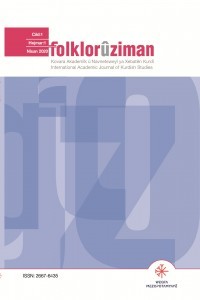COMPARISON OF HAWAR AND RÊBERA RASTNIVÎSÎNÊ YA KOMXEBATA KURMANCÎYÊ IN TERMS OF SPELLING RULES
COMPARISON OF HAWAR AND RÊBERA RASTNIVÎSÎNÊ YA KOMXEBATA KURMANCÎYÊ IN TERMS OF SPELLING RULES
The common language, which is formed thanks to the standard language, not only carries the culture of a nation to the next level for communication, but also increases the literacy rate, and inevitably, a great developoment is observed in publishing. Standardization, which could achieve a good result with state support and the establishment of commissions, developed in different ways for the Kurds. For example, a magazine took on this role. Celadet Alî Bedirxan carried out this “unofficial” commission with his friends in his journal Hawar. This magazine was the first Kurdish magazine to be published in the Latin alphabet and included dictionaries and grammar studies. A few spelling guides were published after Hawar magazine. One of them is Rêbera Rastnivîsînê, published by Komxebata Kurmancîyê. The aim of this study is to compare Hawar and Rêbera Rastnivîsînê in the terms of orthographic rules.
Keywords:
standardization, Hawar, Rêbera Rastnivîsandinê, Celadet Alî Bedirxan language standardization,
___
- Aydogan, M. (2012). Rêbera Rastnivîsînê. İstanbul: Rûpel.
- Bedir-Xan, C. A. (1998). Ber Tevna Mehfûrê. (F. Cewerî, Amd.) Hawar, 1(4), 83-86.
- Bedir-Xan, C. A. (1998). Elfabêya Qurdî. (F. Cewerî, Amd.) Hawar, 1(7), 148.
- Boulden, L. (Payîz 2007). Standardbûna Zimên. Kovara Zend, 54-62.
- Cevdet, D. A. (2013). Bir Hitap. (K. Ç. Grubu, Amd.) Rojî Kurd(1), 241-242.
- Cewerî, F. (Amd.). (1998). Elfabêya Qurdî. Hawar, 1(6), 128.
- Cewerî, F. (Amd.). (1998). Gelawêj. Hawar, 2(27), 692.
- Cewerî, F. (Amd.). (1998). Pêşgotingeq. Hawar, 1(13), 263-264.
- Cobarrubias, J. (1983). Language Planning: The State of the Art. J. A. Juan Cobarribuas (Ed.), Progress in Language Planning: International Perspectives (r. 3-26). Berlin: Walter de Gruyter&Co.
- Fishman, J. A. (1973). Language modernization and planning in comparison with other types of national modernization and planning. Language in Society, 2(1), 23-43.
- Fishman, J. A. (2006). Do Not Leave Your Language Alone-The Hidden Status Agendas Within Corpus Planning in Language Policy. London: Publishers Mahwah.
- Haugen, E. (1983). The Implementation of Corpus Planning: Theory and Practice. Cobarrubias J., Fishman J. A.(Ed.), Progress in Language Planning: International Perspectives (s. 269-289). Berlin: Walter de Gruyter&Co.
- Bedir Khan, D. A. (1998). L'Alphabet Kurde. (F. Cewerî, Amd.) Hawar, 1(3), 69-71.
- Kurmancîyê, K. (2019). Rêbera Rastnivîsînê. Stenbol: Weqfa Mezopotamyayê.
- Önen, R. (2018). Ziman û Netewesazî-Lêhûrbûnek li ser Kovara Hawarê. (werg. Ş. Kurt,) İstanbul: Peywend.
- Picard, P. (Mars 1994). Aux Sources de l'Academie Française. Revue des Deux Mondes, 114-123.
- Rebourcet, S. (Printemps 2008). Le français standard et la norme: l'histoire d'une "nationalisme linguistique et littéraire" à la française". école doctorale de The School of Languages, Literatures and Cultured de l'Université de Maryland, 2(1), 107-118.
- Sadoğlu, H. (2010). Türkiye'de Ulusçuluk ve Dil Politikaları. İstanbul: İstanbul Bilgi Üniversitesi.
- X, M. (2013). Ziman û Nezaniya Kurdan. (K. Ç. Grubu, Dü.) Rojî Kurd(2), 160-162.
- Bedir Xan, C. A. (1998). Elfabêya Qurdî. (F. Cewerî, Amd.) Hawar, 1(3), 65-66.
- ISSN: 2667-6435
- Başlangıç: 2020
- Yayıncı: Mezopotamya Eğitim Bilim Sanat Sağlık Ve Kültür Vakfı İktisadi İşletmesi
